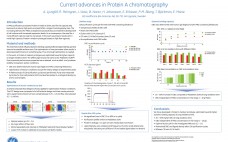APT1604 is a base-stable 600 Da peptidometic ligand coupled to a 6% cross-linked agarose matrix. APT1604 binds to Fc-fragment of monoclonal antibodies (mAb) and various immunoglobulin (IgG) subclasses. The interaction between protein and ligand has been suggested to result from mixed mode ionic – hydrophobic interactions, albeit with high selectivity for immunoglobulins. The main application area for APT1604 is purification of mAb from mammalian cell harvest, but it can also be used for purification of IgG from other sources. The…
Downstream Processing
Current advances in Protein A chromatography
In this work we present results with a novel high capacity Protein A medium prototype based on high flow agarose. The medium prototype was optimized for higher dynamic binding capacity (DBC) at long residence time. A 20–50% higher DBC was obtained compared to MabSelect SuRe™. DBC was independent of MAb concentration in the range 1–10 g/L. Optimization of elution conditions (pH and flow rate) was performed by design of experiments. A lifetime study for 100 purification cycles, performed with a…
Factory of the Future
Fed-batch and perfusion culture are two dominant modes of operation for mammalian-cell-culture based processes. Challenges in the industry (such as competitive products for the same indication or desired cost reductions) are forcing many to explore new production options. Increasingly popular is the application of the ATF™ System to generate ultra high viable cell concentrations (>100m cells/ml) for a “concentrated” or “intensified” process. The use of the ATF System in a typical concentrated fed-batch process is shown which has generated a…
Improving influenza vaccine quantification; a comparative study of SRID and SPR
Reliable analytical tools are valuable for economical process development, production, and batch release of vaccines. The current method recommended by the European Pharmacopoeia and WHO for determination of influenza virus titer ¬ single radial immunodiffusion assay (SRID) is straightforward and easy, but leaves plenty of room for improvement when it comes to assay variability and speed of analysis. In addition to having low sensitivity and precision, the method is both time-consuming and quite labor-intensive. In this study a Biacore™ assay…
Sartorius Stedim Biotech Filtration Trials with SAFC Ex-Cell Hydrolysate Fusion
SAFC has launched EX-CELL® CD Hydrolysate Fusion, the first fully chemically defined media supplement of its kind in the industry. Sartorius Stedim Biotech and SAFC Biosciences have recently announced a wide-ranging joint cooperation agreement to serve their customers. As a consequence of this effort, a range of 0.2 ÎĽm & 0.1 ÎĽm sterilizing grade filters from different membrane materials were tested for throughput & biological activity post-filtration. This paper provides an insight into superior total throughput performance of the Sartorius…
Critical aspects for mixing of stratified solutions in vertical bags
With increasing use of single-use, disposable fluid processing systems, concerns of mixing arise in processes such as protein concentration, clarification and diafiltration. For some operating conditions of flow rate, solution viscosity or flow path configurations, protein solutions may become stratified in vertically-oriented hanging bags. This can cause decreased efficiency in cross flow applications. In this study, we modeled a stratified solution and tested the influence of these various operating conditions using ReadyCircuit* 2-D pillow bags. Even with viscous materials, flow…
Facing the Challenges in Bio-Pharmaceutical Production
Much attention has been given to ion exchange (IEX) media as a means to improve productivity as a result of increasing demand for higher efficiency on the downstream process. Until recently, strain optimisation for high productivity and upstream purification were the bottlenecks for most bio-processes. However, with the progress made in recent years, titers in fermentation processes have increased significantly. Obviously, this increased volumetric productivity will help reducing the cost of goods, but it also has an impact on the…
Monoliths Open the Door to Key Growth Sectors
The enabling value of monoliths was strongly in evidence at the 4th International Monolith Symposium, held 29 May – 2 June in the Adriatic resort city of Portoroz, Slovenia. Forty-seven oral presentations and 34 posters highlighted important advances in vaccines, gene therapy, phage therapy for infectious disease, and monoclonal antibodies, as well as continuing advances in the performance of monoliths themselves. As these fields advance in parallel, it becomes increasingly apparent that monoliths offer industrial capabilities substantially beyond…
How to Choose an Industrial Cation Exchanger for IgG Purification
Cation-exchange chromatography is the third most used industrial method for antibody purification after anion-exchange and protein A affinity chromatography. It is most commonly used as an intermediate step but continues to attract attention as a capture method. This offers obvious cost and cleaning advantages over protein A but also imposes some sacrifices, all of which are discussed in a number of recent articles (1,2,3,4,5). Whichever application may be intended, end users seek a common set of performance characteristics.…
Rapid and Scalable Microplate Development of a Two-Step Purification Process
High-throughput screening and process development methods are becoming more widely used in the biopharmaceutical industry. Recent development of high-expression (high–target-titer) recombinant culture methods has enhanced the need to also develop more effective separation products, methods, and processes (1). Part of the solution would be chromatographic resins offering higher capacities and flow rates. However, developing an optimized purification process that involves several chromatographic steps can consume significant time and samples. In addition, a purification process developed…







